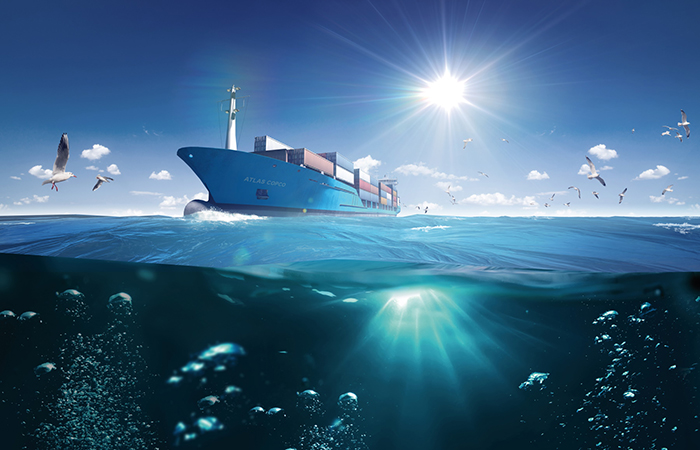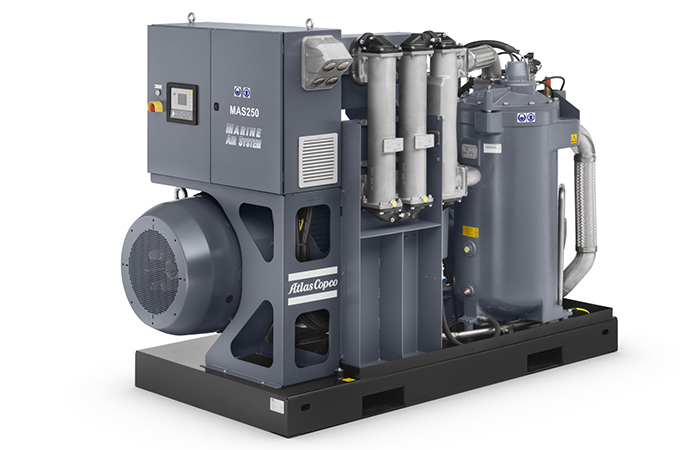
In the engine room or on-deck site, marine compressor systems are vital elements that must be specifically designed for multiple duties as an integral part of shipboard operations. They have to be robust machines able to perform reliably within the environmental conditions experienced while operating in mid-ocean, often days or weeks away from landfall and servicing facilities.
As marine compressor solutions become ever more sophisticated, specialised and energy-efficient, it is a wise precaution for ship owners and shipyards making equipment choices to examine the application roles, the equipment options, and the regulatory framework specific to maritime operations − the important factors to be considered in meeting the challenging engineering environment within today’s global shipping operations.
The starting point for these considerations has to be the principal duties of shipboard compressors.
Principal compressor duties
The first and foremost duty for the compressor is providing starting air for the main engines, normally at a pressure of 30 bar. Then follows the need for starting air for diesel generating sets which can be at 10 or 30 bar pressure depending on the starting air method, either direct in the cylinder or by a starting air motor.
High quality, clean, dry, oil-free air at 7-8 bar is an equally essential requirement for consistently accurate performance of vital bridge instruments, such as monitoring and engine control systems. It is also required for cargo pumps turbine governors and LNG/LPG cargo instrument air applications. Also needing clean dry air, is a vessel’s main engine remote control pneumatic systems, tank gauging operations, together with temperature and pressure controls.
At the same time, an efficient supply of low-pressure working air is an essential requirement for a wide range of other important applications − for tools, air-operating lights, air-operated fans, dry bulk handling, nitrogen booster compressor operation, ballast water treatment, soot filtration, exhaust gas cleaning equipment, air for sewage systems − everything from regular maintenance to bulk handling needs a 7 bar-13.8 bar air supply on tap.
And finally, there are specialist applications such as medical air or high-pressure air for seismic operations, bubble curtains and for diving or air breathing apparatus bottle filling.

The equipment criteria
Within the practical shipboard constraints of minimum power consumption and restricted installation space, it is vital for shipyards and shipowners to ensure that the performance and build quality of a marine compressed air system can meet the operational criteria for reliability, energy efficiency, stability, safety, and regulatory compliance.
Reliability: That has to be the watchword for all essential shipboard systems. Marine compressors must be fully optimised for shipborne use and be designed and constructed for continuous operational capability within engine room environments of up to 50 degrees C ambient. That means robust, tried and tested components and ancillaries that combine the benefits of long service intervals and energy-efficient whole life performance.
Stability at sea: The compressors’ component configuration should be designed to provide a low centre of gravity that minimises equipment stress even in severe running conditions. It must comply with the Lloyd’s Register Rules and Regulations of operating conditions for main and auxiliary machinery that: ‘installed equipment can operate normally in rough seas at an angle of inclination athwartships of 15 degrees static/ 22.5 degrees dynamic and 5 degrees fore-and-aft static/7.5 degrees dynamic’.
Electrical safety: Under the Lloyds’ regulations concerning location and construction of electrical installations, all electrical equipment is to be constructed or selected and installed such that live parts cannot be inadvertently touched, do not cause injury when handled or touched in the normal manner; and are unaffected by any water, steam or oil and oil vapour to which it is likely to be exposed.
Accessibility and compact dimensions: This is a major issue in equipment siting. However large a vessel may be, the engine room space is always at a premium. That is why the best option is to match required performance to equipment designed with fully integrated components, such as air dryers, thereby offering the smallest footprint.
A compact compressor’s dimensions should allow installation access through standard ship-sized doors and thus avoid hot work necessary to accommodate the unit. For the same reason, air connections and ancillaries such as condensate drains should be located at one side of each unit to allow maximum proximity to bulkheads and provide easy access for routine maintenance procedures.
Compliance: It is importance to establish that the materials, construction, and environmental impact of shipboard compressor equipment conforms to the rules, inspections, and certification procedures of the major recognised classification organisations. Lloyd's Register and American Bureau of Shipping, DNV, RINA, RMRS are just some of the major companies in the classification society business whose focus is to ensure owners and shipyards conform to the safety, security and quality standards set by the shipping industry.
It is the equipment manufacturers and suppliers responsibility to comply with
all major classifications and Environmental Protection notations such as EP, clean design; comfort notations; environmental performance monitoring; and Green Passports (Inventory of Hazardous Materials).
All ships also have to comply with the Annex IV of MARPOL 73/78 Regulations for the Prevention of Pollution by Sewage from Ships and have to be equipped with sewage plants. To keep them in proper working condition and good balance, the sewage plant needs air to stimulate the growth of the bacterial culture. This application requires low pressure, clean and guaranteed oil-free air, best delivered by the latest low-pressure compressor screw blowers whose energy requirement is on average 30% more energy-efficient than conventional Roots-type lobe blowers.
Energy efficiency
Finally, the ultimate goal is for marine compressor equipment that demonstrates significant energy efficiency. Much has been achieved by the advanced design of key components, such as the non-contact intermeshing screw elements of an oil-free compressor, the sophisticated control algorithm of the electronic regulator used to control the speed of a compressor’s induction motor. But the most significant benefit of all is VSD technology that closely follows the air demand, automatically adjusting the motor speed, and results in achieving energy savings of up to 35% and even more.
Linked to this goal is the overriding requirement for marine compressor installations whose design and efficiency generates sustainable onboard productivity for the owners and operators yet presents no risk for the global environment.
Air power for RRS Sir David Attenborough
As a practical example of the need for custom solutions to marine air power needs, shipbuilders Cammell Laird Construction installed Atlas Copco marine-duty compressors aboard one of the most advanced polar research vessels in the world, RRS Sir David Attenborough.
The vessel’s full spectrum of compressed air duties was met from Atlas Copco’s MAS range of marine compressors, technically advanced solutions fully optimised for shipborne use. The MAS family of 5-90 kW oil-injected screw marine compressors, derived from its premium GA range of stationary industrial units, sets the standard in marine compressed air production, combining low cost of ownership with reliable, energy-efficient performance.
However, even the most advanced compressors offering long maintenance intervals and service lives still need attention. That is why Atlas Copco offers parts and services packages which provide peace of mind while vessels are at sea.
Worldwide marine service support
Service support for the RRS Sir David Attenborough installation was provided in a seamless transition from inception and commissioning to full-time operational duties across the world. Atlas Copco's global presence meant that while consultation, engineering and design could be carried out in the UK, servicing, spare parts supply, training, and technical support was to be supplied locally wherever it was required.
With Atlas Copco’s Marine Compressor Parts & Service operation, Atlas Copco compressor parts, and OEM non-Atlas Copco parts, can be ordered from the UK and delivered direct to freight forwarders or anywhere on the planet, such as within 24 hours to Europe, 48 hours to America, and 72-96 hours to the rest of the world.
Customised parts plans are specifically created for marine customers by building a maintenance schedule that offers genuine parts, and timely parts delivery, with less administration hassle involved.
Over 3600 Atlas Copco field service engineers in 180 countries are ready to attend onboard when assistance is needed for major services and overhauls. The range of marine maintenance services available includes oil sampling, inspection service onboard ship once a year in major hubs around the world, and provision of crew training.
The role of SmartLink
Knowing the status of marine compressed air equipment at all times is the surest
way to spot any developing problems, uncover potential energy savings, and
achieve maximum uptime of the compressed air systems. These insights can be realised through SmartLink, Atlas Copco’s remote data monitoring system that works via a vessel’s internet (satellite) network, and where compressor data will be continuously updated. Alternatively, SmartLink can rely on passing through network coverage areas and data can be uploaded from there.
Conclusion
When it comes to marine compressor applications it is evident that there is no one-size-fits-all solution. Each machine installation requires matching specification and performance to the shipborne equipment and the operational profile.
Equally, the hardware installation has to be supported by a worldwide onshore service and parts support network. In making equipment choices there is no doubt that shipyards and shipowners will give preference to suppliers who can offer a wide range of compressor options, a 24/7 global support network of marine experts, based in all major industrial ports, together with an immediate OEM parts supply backed by informed maintenance procedure guidance.
Editor’s Notes
- Typical shipboard compressor equipment is determined by the application:
- Piston compressors for starting air
- Diesel or electrical driven piston air compressors for emergency starting air
- Oil-injected screw compressors for working air
- Oil-free screw compressors for instrument air
- Piston compressors for breathing air
- Turbo compressors for large volumes of compressed air;
- Turbo compressors for re-liquefied plants dual fuel compressors on gas carriers.
- Nitrogen compressors
- Inert gas compressors
- Oil-free blower air for sewage systems
- Atlas Copco has developed high pressure nitrogen packages required for purging the fuel gas supply systems (FGSS) engines of ships which utilise alternative shipping fuels (LNG, LPG, Ethane, Ammonia).
Website for publication: https://www.atlascopco.com/en-uk/compressors/air-compressor-repairs/marine-air-compressor-parts-and-service










UK Enters ‘Golden Age of Nuclear’
The delay (nearly 8 years) in getting approval for the Rolls-Royce SMR is most worrying. Signifies a torpid and expensive system that is quite onerous...